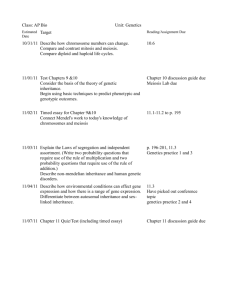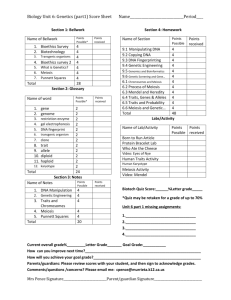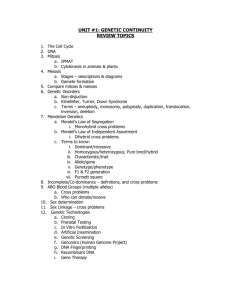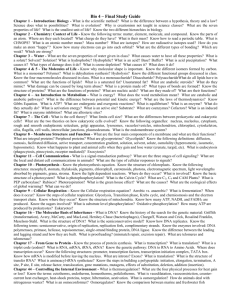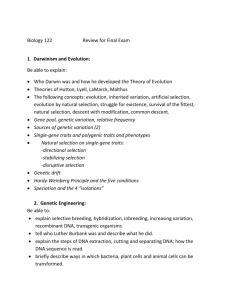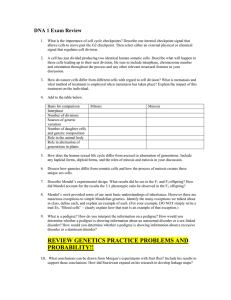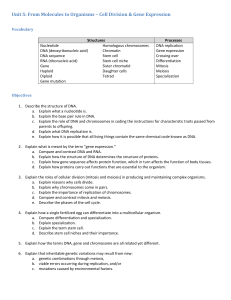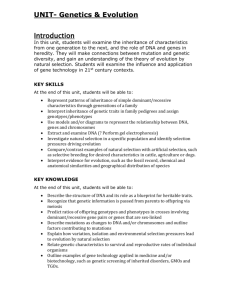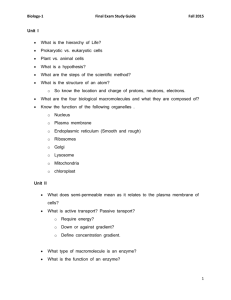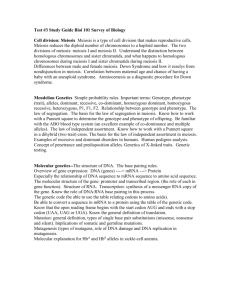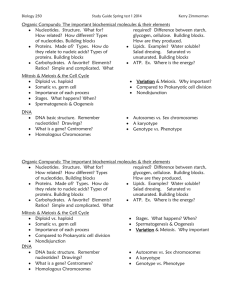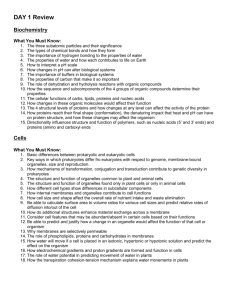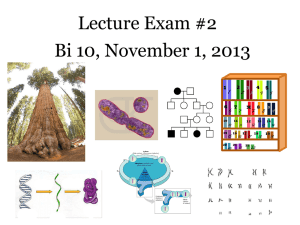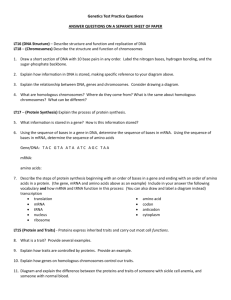Major Topics Assessed on the Biology Honors Final Exam This
advertisement
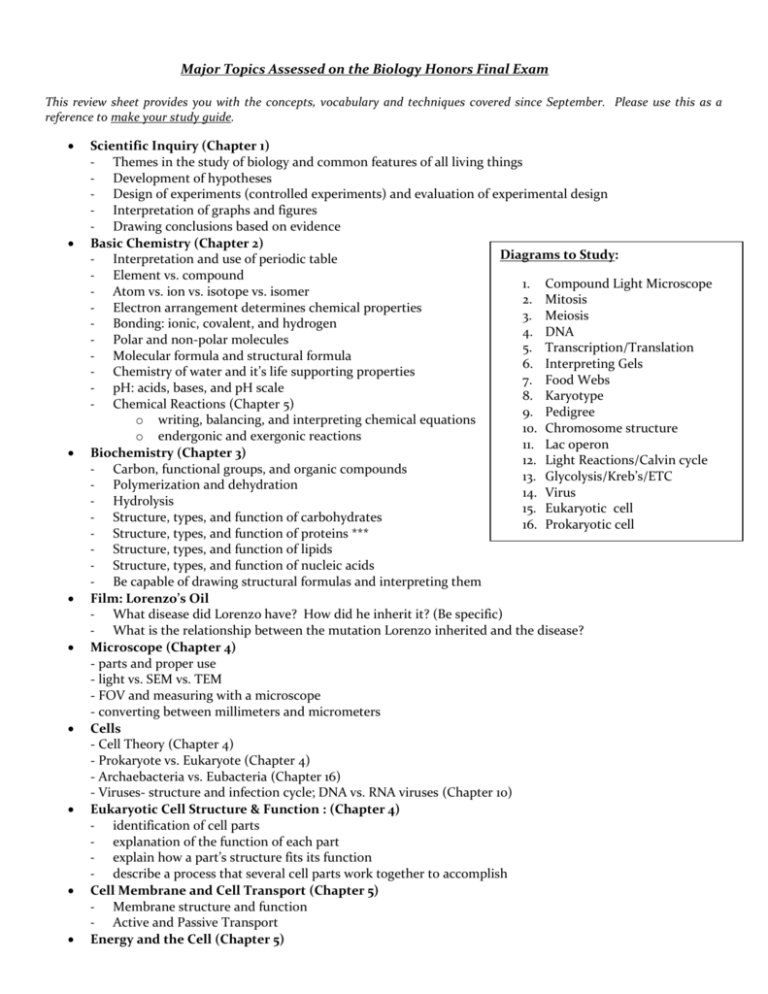
Major Topics Assessed on the Biology Honors Final Exam This review sheet provides you with the concepts, vocabulary and techniques covered since September. Please use this as a reference to make your study guide. Scientific Inquiry (Chapter 1) - Themes in the study of biology and common features of all living things - Development of hypotheses - Design of experiments (controlled experiments) and evaluation of experimental design - Interpretation of graphs and figures - Drawing conclusions based on evidence Basic Chemistry (Chapter 2) Diagrams to Study: - Interpretation and use of periodic table - Element vs. compound 1. Compound Light Microscope - Atom vs. ion vs. isotope vs. isomer 2. Mitosis - Electron arrangement determines chemical properties 3. Meiosis - Bonding: ionic, covalent, and hydrogen 4. DNA - Polar and non-polar molecules 5. Transcription/Translation - Molecular formula and structural formula 6. Interpreting Gels - Chemistry of water and it’s life supporting properties 7. Food Webs - pH: acids, bases, and pH scale 8. Karyotype - Chemical Reactions (Chapter 5) 9. Pedigree o writing, balancing, and interpreting chemical equations 10. Chromosome structure o endergonic and exergonic reactions 11. Lac operon Biochemistry (Chapter 3) 12. Light Reactions/Calvin cycle - Carbon, functional groups, and organic compounds 13. Glycolysis/Kreb’s/ETC - Polymerization and dehydration 14. Virus - Hydrolysis 15. Eukaryotic cell - Structure, types, and function of carbohydrates 16. Prokaryotic cell - Structure, types, and function of proteins *** - Structure, types, and function of lipids - Structure, types, and function of nucleic acids - Be capable of drawing structural formulas and interpreting them Film: Lorenzo’s Oil - What disease did Lorenzo have? How did he inherit it? (Be specific) - What is the relationship between the mutation Lorenzo inherited and the disease? Microscope (Chapter 4) - parts and proper use - light vs. SEM vs. TEM - FOV and measuring with a microscope - converting between millimeters and micrometers Cells - Cell Theory (Chapter 4) - Prokaryote vs. Eukaryote (Chapter 4) - Archaebacteria vs. Eubacteria (Chapter 16) - Viruses- structure and infection cycle; DNA vs. RNA viruses (Chapter 10) Eukaryotic Cell Structure & Function : (Chapter 4) - identification of cell parts - explanation of the function of each part - explain how a part’s structure fits its function - describe a process that several cell parts work together to accomplish Cell Membrane and Cell Transport (Chapter 5) - Membrane structure and function - Active and Passive Transport Energy and the Cell (Chapter 5) - Laws that govern energy transformation - ATP-ADP cycle - How enzymes function Cycling of Matter and Flow of Energy in the Biosphere (Chapter 6, 7, and 37) - Oxygen and Carbon cycles - Role of photosynthesis and cell respiration in the cycles and moderation of global warming - Photosynthesis - equation, reactants, products, requirements, light reactions, and Calvin cycle - Cell Respiration- equation, reactants, products, requirements, glycolysis, Krebs (citric acid) cycle, and Electron Transport Chain (oxidative phosphorylation) - Food chains, food webs, 10% rule, and ecological pyramids Cell Reproduction (Chapter 8) - Prokaryotes rely on binary fission - Cell cycle - Eukaryotes rely on mitosis & cytokinesis - Cancer (Chapter 8 & 11) - Meiosis: stages, goal of Meiosis I, goal of Meiosis II, and events such as tetrad formation and crossing over - Chromosomal mutations, karyotypes, and genetic disorders DNA (Chapter 10 & 11) - Structure and function - Replication - Gene Expression o DNA RNA Protein (Central Dogma) o Protein synthesis o Gene mutations o Regulating Gene Expression in Prokaryotes (operons) o Regulating Gene Expression in Eukaryotes (master control genes, switches, etc) Genetics (Chapter 9) - Mendel’s Laws of Heredity - one factor crosses - two factor crosses - Genetic recombination (draw the connection between events of meiosis that explain Mendel’s observations) - Interpreting a pedigree - Complex Patterns of Inheritance: o Incomplete dominance o Codominance o Sex-Linked Inheritance o Multiple Alleles o Polygenic Traits - Other factors that affect expression of traits (environment and epigenetics) Evolution (Chapter 13, 14, & 15) - Darwin, descent with modification, and natural selection - Evidence for evolution - Explain how genetic variation makes evolution possible - Use of Hardy-Weinberg equation to assess if a population is evolving - Mechanisms of microevolution- natural selection, genetic drift, and gene flow - Macroevolution and speciation (adaptive radiation) - Divergent vs. convergent evolution - Gradualism vs. punctuated equilibrium - Phylogeny Biotechnology (Chapter 12) - Gene Cloning - GMO’s - DNA Profiling/ Gel electrophoresis - Genomics
